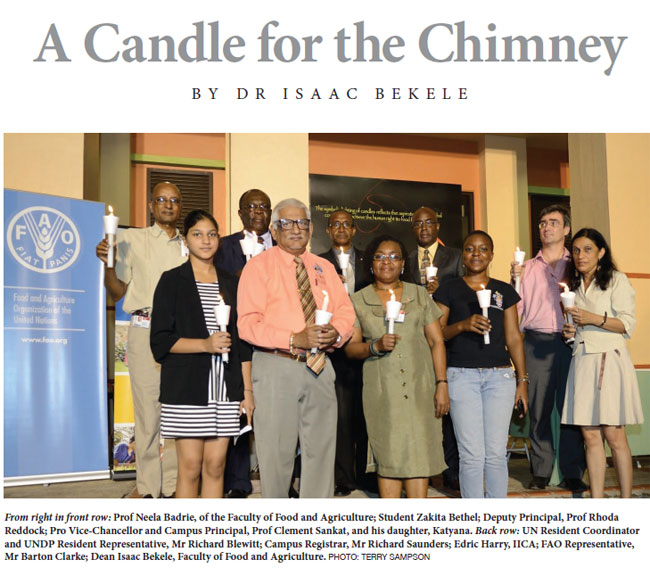|
December 2013

Issue Home >>
|

We live on a planet where each hour approximately 920 persons die due to hunger. This, in a nutshell, means roughly the size of the population of staff and students of UWI in St Augustine perishes each day for lack of food. These persons die because they cannot access food for whatever reason. The irony of it all is that over 1.6 billion persons alive today are overweight and face lifestyle health risks. These are victims of unhealthy diets. As we stand here, there are nearly 7.2 billion persons alive today and the population grows annually at a rate of 64 million. The state of the global population is not where it should be in terms of access to food, nutrition and healthy living as well as size in relation to food production and productivity.
Although there is a chance of bringing more arable land under cultivation globally, nearly 5.5 million hectares of land is lost due to soil erosion and another 9.5 million lost to desertification annually. Over four million hectares of forest is cleared each year and nearly 7.5 million tonnes of toxic waste is released into the environment annually. The planet has become a “chimney” spewing almost 27 billion tonnes of carbon dioxide annually, and, by 2030, close to 50% of the world’s population will live in areas of high water stress. The environment, which sustains our life, is itself under stress.
The Food and Agriculture Organization of the United Nations, at the 20th General conference of member countries in November 1979, declared October 16, the day of the formation of the Organization in 1945, as a day for annual observance of the World Food Day. As we ponder on the significance of this day, we need to do so with a collective belief that the challenge of feeding the world, however daunting it may appear, is ultimately surmountable through commitment, dedication, involvement and mobilization of global resources and sustained effective action. The aim is to achieve food and nutrition security through sustainable food systems by overcoming environmental and natural resource challenges.
As we light candles and walk around the circular road in front of this historic building, the site of the former Imperial College of Agriculture, let us ponder on the sombre challenge humanity faces to meet the deficit in food and nutrition in order to sustain a growing and healthy population no matter where they reside and to cater for the well-being of future generations.
This World Food Day candlelight vigil is organized in collaboration with the FAO Trinidad and Tobago country Office. I would like to recognize their collaboration and input in this worthwhile event. I would like to express my sincere gratitude to Mr Barton Clarke, the FAO mission Head in Trinidad and Tobago for his support and commitment to this cause. I am also grateful to Principal Sankat for his enduring support and advocacy for agriculture.
IICA has also been part of World Food day vigils and this year is no different. I would like to express my gratitude to Mr Gregg Rawlins, the Head of IICA in Trinidad and Tobago through his colleague, Mr Edric Harry who represents him on account of his absence from the country.
The St Augustine Campus of The UWI marked World Food Day on October 17, 2013, with a candlelight vigil. This year’s theme was “Sustainable food systems for food and nutrition security.” The event was organised by the Faculty of Food and Agriculture, where Dr Isaac Bekele is Dean.
|





